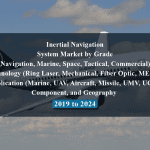OVERVIEW
The Connected Aircraft Market is currently valued at USD 10 billion in 2024 and will be growing at a CAGR of 10.6% over the forecast period to reach an estimated USD 16.5 billion in revenue in 2029. The connected aircraft market is witnessing exponential growth driven by technological advancements and the increasing demand for enhanced inflight connectivity and operational efficiency. These aircraft are equipped with advanced communication systems, including satellite-based internet, enabling passengers to stay connected while in the air. Moreover, connected aircraft offer benefits such as real-time monitoring of systems, predictive maintenance, and data analytics, which optimize flight operations and reduce downtime. With the aviation industry continuously striving to improve safety, passenger experience, and cost-effectiveness, the connected aircraft market is poised for sustained expansion, attracting investments from both established aviation players and technology firms aiming to revolutionize the airborne experience.
Firstly, the escalating demand for inflight connectivity services and the proliferation of internet-enabled devices among passengers are significant drivers. This demand is further fueled by the increasing preference for seamless connectivity and entertainment options during air travel. Additionally, airlines are increasingly adopting connected aircraft solutions to enhance operational efficiency through real-time data monitoring, predictive maintenance, and fuel optimization, thereby reducing costs and improving overall performance. Moreover, regulatory mandates for improved aircraft tracking and communication, coupled with the emergence of advanced technologies like satellite-based communication systems and IoT solutions, are driving the market forward. Furthermore, the growing emphasis on enhancing passenger experience, safety, and environmental sustainability is pushing airlines and aircraft manufacturers to invest in connected technologies, thereby fostering market growth
Table of Content
Market Dynamics
Drivers:
Firstly, the escalating demand for inflight connectivity services and the proliferation of internet-enabled devices among passengers are significant drivers. This demand is further fueled by the increasing preference for seamless connectivity and entertainment options during air travel. Additionally, airlines are increasingly adopting connected aircraft solutions to enhance operational efficiency through real-time data monitoring, predictive maintenance, and fuel optimization, thereby reducing costs and improving overall performance. Moreover, regulatory mandates for improved aircraft tracking and communication, coupled with the emergence of advanced technologies like satellite-based communication systems and IoT solutions, are driving the market forward. Furthermore, the growing emphasis on enhancing passenger experience, safety, and environmental sustainability is pushing airlines and aircraft manufacturers to invest in connected technologies, thereby fostering market growth.
Key Opportunities :
The connected aircraft market presents numerous key opportunities for industry players. Firstly, there is immense potential for further innovation and development in inflight entertainment and connectivity services to cater to evolving passenger preferences and expectations. Moreover, the integration of advanced analytics and artificial intelligence technologies offers opportunities for airlines to optimize flight operations, improve fuel efficiency, and enhance maintenance processes. Additionally, the expansion of connected aircraft solutions into new market segments such as business aviation and unmanned aerial vehicles (UAVs) opens up avenues for growth. Furthermore, partnerships and collaborations between airlines, technology providers, and aerospace companies can unlock synergies and drive the adoption of connected aircraft solutions globally. Lastly, the growing demand for aircraft health monitoring systems and cybersecurity solutions presents opportunities for companies specializing in these areas to address emerging challenges and strengthen the resilience of connected aircraft ecosystems.
Restraints :
Concerns regarding data security and privacy remain significant barriers to widespread adoption, particularly as connected systems increase the risk of cyber threats and hacking. Additionally, the high initial investment required for retrofitting existing aircraft with connectivity solutions and the complexity of integrating these technologies into legacy systems pose challenges for airlines, especially those with tight budget constraints. Furthermore, regulatory hurdles and certification processes can delay the deployment of connected aircraft solutions, hindering market growth. Moreover, the ongoing COVID-19 pandemic has disrupted the aviation industry, leading to reduced air travel demand and financial constraints for airlines, thereby impacting investments in connected aircraft technologies. Lastly, the potential for over-reliance on connectivity solutions and digital systems may raise concerns regarding system failures and operational disruptions, necessitating robust contingency plans and redundancy measures.
Regional Information:
• In North America, the connected aircraft market is propelled by the region’s robust aviation industry, technological innovation, and high demand for inflight connectivity services. With major airlines investing in modernizing their fleets and offering premium passenger experiences, there is a significant opportunity for the adoption of advanced connectivity solutions. Moreover, the presence of leading technology companies and aerospace manufacturers further accelerates market growth, driving the development of cutting-edge technologies such as satellite-based communication systems and data analytics platforms. Regulatory initiatives aimed at enhancing aircraft communication and tracking systems also contribute to market expansion.
• In Europe, the connected aircraft market benefits from stringent safety regulations, increasing air traffic, and a strong focus on sustainability. European airlines are embracing connected technologies to improve operational efficiency, reduce emissions, and enhance passenger satisfaction. Furthermore, collaborations between airlines, technology providers, and research institutions foster innovation and drive market growth.
• In Asia-Pacific, rapid economic growth, rising air travel demand, and government initiatives to modernize aviation infrastructure stimulate the adoption of connected aircraft solutions. With the region witnessing a surge in air passenger traffic, airlines are investing in inflight connectivity to differentiate their services and cater to the preferences of tech-savvy travelers.
Recent Developments:
• In May 2023, FlyExclusive chose Gogo Inc.’s popular AVANCE platform to upgrade 40 of their private aircraft. The decision was taken to benefit from Gogo’s acclaimed connectivity and customer service, enhancing the overall experience for their passengers.
• In June 2023, Honeywell announced the signing of a Memorandum of Understanding (MOU) with ST Engineering. The collaboration aims to explore potential opportunities in retrofit, modification, and upgrade (RMU) programs for both fixed-wing and rotary-wing aircraft platforms.
Key Market Players:
Boeing, Airbus, Honeywell International, Thales Group, Panasonic Avionics Corporation, Gogo Inc., Inmarsat plc, Viasat Inc., Collins Aerospace (Raytheon Technologies company), and SITA
Frequently Asked Questions
1) What is the projected market value of the Connected Aircraft Market ?
– The Connected Aircraft Market is expected to reach an estimated value of USD 16.5 billion in revenue by 2029.
2) What is the estimated CAGR of the Connected Aircraft Market over the 2024 to 2029 forecast period?
– The CAGR is estimated to be 10.6% for the Connected Aircraft Market over the 2024 to 2029.
3) Who are the key players in the Connected Aircraft Market ?
– Boeing, Airbus, Honeywell International, Thales Group, Panasonic Avionics Corporation, Gogo Inc., Inmarsat plc, Viasat Inc., Collins Aerospace (Raytheon Technologies company), and SITA.
4) What are the drivers for the Connected Aircraft Market ?
– The growing demand for inflight connectivity services, internet-enabled devices, and seamless air travel options are driving the market. Airlines are adopting connected aircraft solutions for operational efficiency, cost reduction, and improved performance. Advanced technologies, regulatory mandates, and a focus on passenger experience, safety, and sustainability also contribute to market growth.
5) What are the restraints and challenges in the Connected Aircraft Market ?
– Data security, privacy, and cost are major barriers to widespread adoption of connected aircraft solutions. High initial investment, complexity, regulatory hurdles, and the COVID-19 pandemic have further impacted investments. Over-reliance on connectivity solutions may also raise concerns about system failures and operational disruptions.
6) What are the key applications and offerings of the Connected Aircraft Market ?
– Boeing, Airbus, Honeywell International, Thales Group, Panasonic Avionics Corporation, Gogo Inc., Inmarsat plc, Viasat Inc., Collins Aerospace (Raytheon Technologies company), and SITA
7) Which region is expected to drive the market for the forecast period?
– North America is expected to have the highest market growth from 2024 to 2029
Why Choose Us?
Insights into Market Trends: Global Market Studies reports provide valuable insights into market trends, including market size, segmentation, growth drivers, and market dynamics. This information helps clients make strategic decisions, such as product development, market positioning, and marketing strategies.
Competitor Analysis: Our reports provide detailed information about competitors, including their market share, product offerings, pricing, and competitive strategies. This data can be used to inform competitive strategies and to identify opportunities for growth and expansion.
Industry Forecasts: Our reports provide industry forecasts, which will inform your business strategies, such as investment decisions, production planning, and workforce planning. These forecasts can help you to prepare for future trends and to take advantage of growth opportunities.
Access to Industry Experts: Our solutions include contributions from industry experts, including analysts, consultants, and subject matter experts. This access to expert insights can be valuable for you to understand the market.
Time and Cost Savings: Our team at Global Market Studies can save you time and reduce the cost of conducting market research by providing comprehensive and up-to-date information in a single report, avoiding the need for additional market research efforts.












